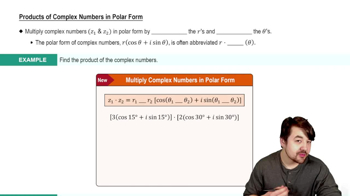Table of contents
- 0. Review of College Algebra4h 43m
- 1. Measuring Angles39m
- 2. Trigonometric Functions on Right Triangles2h 5m
- 3. Unit Circle1h 19m
- 4. Graphing Trigonometric Functions1h 19m
- 5. Inverse Trigonometric Functions and Basic Trigonometric Equations1h 41m
- 6. Trigonometric Identities and More Equations2h 34m
- 7. Non-Right Triangles1h 38m
- 8. Vectors2h 25m
- 9. Polar Equations2h 5m
- 10. Parametric Equations1h 6m
- 11. Graphing Complex Numbers1h 7m
1. Measuring Angles
Complementary and Supplementary Angles
Problem 24
Textbook Question
In Exercises 21–28, an object moves in simple harmonic motion described by the given equation, where t is measured in seconds and d in inches. In each exercise, find the following: a. the maximum displacement b. the frequency c. the time required for one cycle. d = −8 cos π/2 t
 Verified step by step guidance
Verified step by step guidance1
<Step 1: Identify the amplitude of the motion. The equation given is $d = -8 \cos(\frac{\pi}{2} t)$. The amplitude is the absolute value of the coefficient of the cosine function, which is 8. This represents the maximum displacement.>
<Step 2: Determine the angular frequency. The general form of a simple harmonic motion equation is $d = A \cos(\omega t + \phi)$, where $\omega$ is the angular frequency. In this case, $\omega = \frac{\pi}{2}$.>
<Step 3: Calculate the frequency. The frequency $f$ is related to the angular frequency by the formula $f = \frac{\omega}{2\pi}$. Substitute $\omega = \frac{\pi}{2}$ into this formula to find the frequency.>
<Step 4: Find the period of the motion. The period $T$ is the reciprocal of the frequency, $T = \frac{1}{f}$. Use the frequency calculated in Step 3 to find the period, which is the time required for one complete cycle.>
<Step 5: Summarize the findings. The maximum displacement is 8 inches, the frequency is calculated from the angular frequency, and the period is the reciprocal of the frequency.>
Recommended similar problem, with video answer:
 Verified Solution
Verified SolutionThis video solution was recommended by our tutors as helpful for the problem above
Video duration:
3mPlay a video:
Was this helpful?
Key Concepts
Here are the essential concepts you must grasp in order to answer the question correctly.
Simple Harmonic Motion (SHM)
Simple Harmonic Motion is a type of periodic motion where an object moves back and forth around an equilibrium position. The motion can be described by a sinusoidal function, such as sine or cosine, which captures the oscillatory nature of the movement. In this context, the displacement equation indicates how far the object is from its equilibrium position at any given time.
Recommended video:

Products of Complex Numbers in Polar Form
Maximum Displacement
Maximum displacement, also known as amplitude, refers to the greatest distance the object moves from its equilibrium position during its oscillation. In the given equation, the coefficient of the cosine function indicates the amplitude. For the equation d = -8 cos(π/2 t), the maximum displacement is 8 inches, as it represents the peak value of the oscillation.
Frequency and Period
Frequency is the number of cycles an object completes in one second, while the period is the time taken to complete one full cycle. These two concepts are inversely related; frequency (f) is the reciprocal of the period (T), expressed as f = 1/T. In the given equation, the angular frequency can be derived from the coefficient of t in the cosine function, allowing for the calculation of both frequency and period.
Recommended video:

Period of Sine and Cosine Functions

 3:35m
3:35mWatch next
Master Intro to Complementary & Supplementary Angles with a bite sized video explanation from Patrick Ford
Start learningRelated Videos
Related Practice








